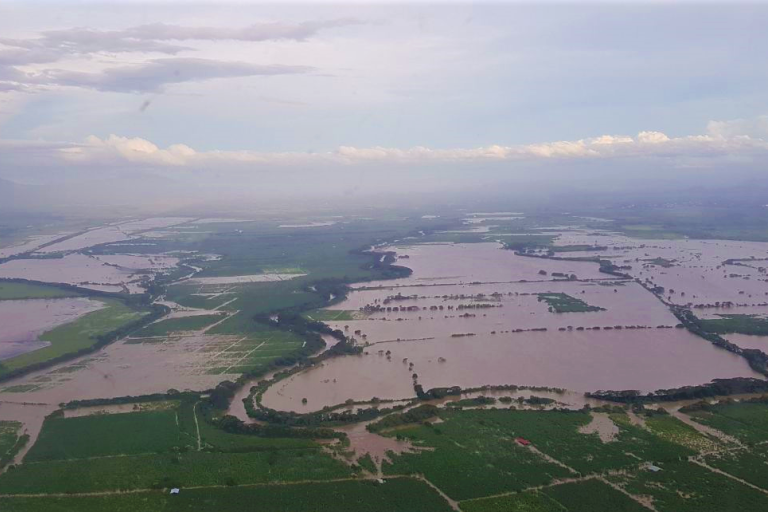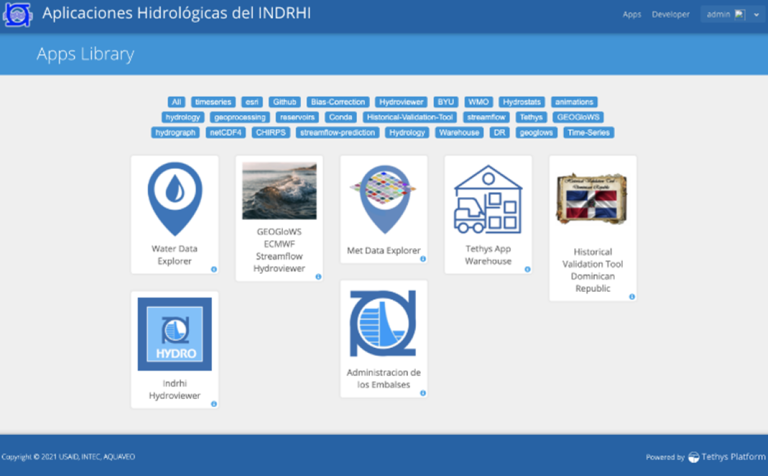Synergies between hydrometeorological systems in the Dominican Republic

Authors
Jim Nelson 1, Jacinto Artigas 2, Angel Aldana 2, Maibys Sierra3, Enrico Boldrini4, Tania Gascon5
1 Brigham Young University, 2 Independent consultant, 3Cuban Meteorological Institute, 4National Research Council of Italy, 5Word Meteorological Organization
1. Introduction
The Dominican Republic is located in the Caribbean Sea on the Hispaniola Island, given its geographical location, it is frequently impacted by hydrometeorological hazards, mainly tropical storms, hurricanes and floods. These have caused loss of life and impacts in productive sectors such as agriculture, industry, etc., often resulting in high economic losses for the country (e.g in 2017, the Ministry of Economy, Planning and Development reported that losses represented 7.98 % of the public spending budget, 1.5% of the GDP). The World Meteorological Organization (WMO), for several years, has been supporting national institutions in Dominican Republic to strengthen hydrometeorological monitoring and forecasting capacities, and is currently collaborating with the INDRHI (National Hydrological Services) and the ONAMET (National Meteorological Service) in the development of integrated riverine flood forecasting system (IRFF), which will help to improve current the information currently provided to national stakeholders for decision making. This support is provided under the Caribbean component of the Canada CREWS project: “Building Resilience to High-Impact Hydro-meteorological Events through Strengthening Multi-Hazard Early Warning Systems (MHEWS) in Small Island Developing States (SIDS) and Southeast Asia (SEA)”, funded by the Environment and Climate Change of Canada (ECCC).

Figure 1. Geographical location of the Dominican Republic
2. Objectives and scope
The main objectives are to: i) build an integrated riverine flood forecasting system at pilot basins including flood impact-based forecasting information; ii) improve meteorological and hydrological products according to user needs; and iii) facilitate the integration of updated and new meteorological and hydrological products into the National Risk Management System.
The IRFF is designed to provide real time information on hydrological and meteorological conditions, as well as flood forecasts at the national level. The impact-based flood forecasting is targeted at the basin level, in the pilot river basin Yaque del Norte (5500 km2), which is located inland and includes reservoir interventions, and the Haina river basin (565 km2), which discharges to the Caribbean Sea.
3. Global and local systems contributing to an Integrated Riverine Flood Forecasting
The creation of new hydrometeorological monitoring and forecasting systems that use multi-system products available at different scales, and that make use of existing system solutions are the main aspects of integration. The IRFF makes use of products from systems already implemented in Dominican Republic through WMO support, such as: the Severe Weather Forecasting Programme (SWFP), the Flash Flood Guidance System (FFGS), and the Costal Inundation Forecast (CIFI), and relies on the short-term forecast system SISPI (Sistema de Pronóstico Inmediato, in Spanish) implemented by the Cuban Meteorological Institute (INSMET), and the global streamflow forecast GEOGloWS, already introduced by Brigham Young University (BYU). The IRFF also engages with the WMO Hydrological Observation System (WHOS) to facilitate hydrometeorological data exchange, and the WMO Meteorological, Climatological and Hydrological database management system (MCH). As well as, with other resources available at national, regional and basin levels.
IRFF general approach
The methodology for the IRFF system is structured in four main components represented in the Figure 2, and summarized as indicated below:
-
Inputs and initial conditions - Incorporation of quantitative precipitation forecasting (QPF) products from SWFP (AROME – 4km), SISPI (WRF-3km), FFGS (WRF 5km, soil moisture) and local observations.
-
Flood forecasting - Hydrological modelling based on HEC-HMS (through EDAPHI) is conducted at local level, to generate hydrographs at intraday daily scale and simulate the hydrological surface runoff behavior.
-
Flooded impact areas - Hydrodynamic simulations based on upstream river flow and controlled by coastal boundary conditions from the CIFI. This integrates vulnerability and exposure information at a local level.
-
Web platform - Visualization and analysis of IRFF products and other existing products through and adaptation of the GEOGloWS platform customized for INDRHI.

Figure 2. Scheme of the IRFF
The GEOGloWS, is based on ECMWF-GloFAS forecasts and provides daily streamflow ensemble forecasts at higher resolutions, with web services for visualization and data access. This is used to estimate flood impact areas at Haina and Yaque del Norte, and to evaluate its performance and replicability at the national level.
Data exchange and observations supported by WHOS
WHOS (WMO Hydrological Observing System) is a global system to facilitate the exchange of hydrometeorological data (without being stored locally) using an access broker. It provides the Water Data Explorer, that allows real synergy between local and global hydrometeorological data resources, and is built using the same Tethys Web Application Platform used by GEOGloWS. A Meteorological Data Explorer for WHOS is also being developed to facilitate visualization, analysis and data sharing of multi-dimensional gridded data as are typical in meteorological forecasting systems. These Data Explorers provide an Application Programming Interface (API) through Python, exposing the functionalities other uses beyond the web applications, which has allowed them to be used as support for the IRFF. This provides a template that can be implemented in other tools for local modelling and analysis as needed.
Platforms for integrated systems
The IRFF relies on the TETHYS portal already deployed in the Dominican Republic (Figure 3). This Portal has a set of solutions available to create diverse applications and interfaces for hydrologic information and decision support.
Each interface or platform can be configured according to the requirements of a system, and needs required by the hydrological services.

Figure 3. Tethys portal targeted for Dominican Republic
The different components of the IRFF are configured to be linked through the Tethys portal. This in order to provide access to key products that describe past and future meteorological and/or hydrological conditions at the national level, as well as maps of flood impact at the local basins (Figure 4).

Figure 4. Prototype of the IRFF platform linking with meteorological and hydrological forecasting products
4. Perspectives and lessons learned
An important element learned through the implementation of IRFF is that providing better data services triggers greater collaboration and a better return on investment of water data and information systems. The fact that GEOGloWS and WHOS web apps provide standard Python interfaces allows easy integration with the current local solutions for meteorological and hydrological forecasts, as well as with an upcoming groundwater monitoring application in the Dominican Republic.
The Water Data Explorer facilitates access by both the global model (GEOGloWS) and local hydrological models (Hec-HMS) for calibration and validation. The Met Data Explorer makes the meteorological forecasts available beyond the direct use of the local models so that INDRHI and ONAMET staff may use them for other similar applications. The inclusion of the global GEOGloWS streamflow forecasts provides additional information in places where a local model exists and allows for coverage in other regions so that there is one consistent baseline of streamflow forecasts.
The use of Tethys allows custom applications to be created that use the global and local models combined with the in-situ measurements for targeted hydrologic information necessary to support specific decision-making activities such as provided through the future WMO Hydrological Status and Outlook System (HydroSOS) applications. Developments in the Dominican Republic could be replicated, adapted, and grown in other areas that rely on similar models and data. Ultimately a library or warehouse of applications can be created and shared amongst the meteorological and hydrological services to create a collaborative community resource, strengthening the cooperation between meteorological and hydrological services. Finally, the system solutions applied in Dominican Republic can be adapted to support hydrological sub-seasonal and seasonal predictions, in line with HydroSOS.

